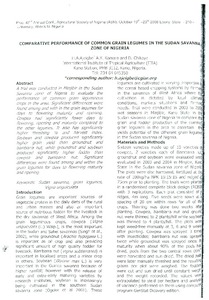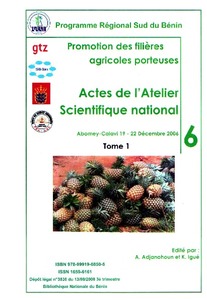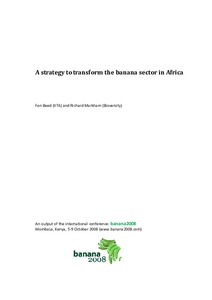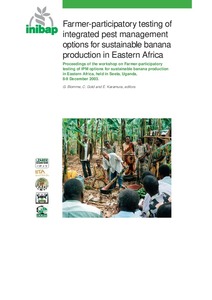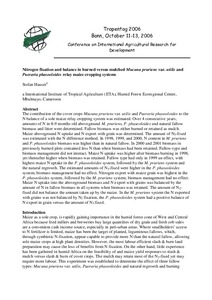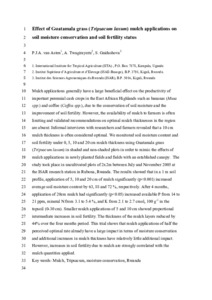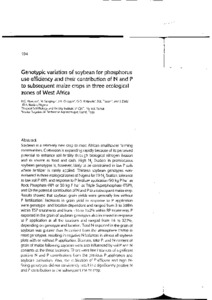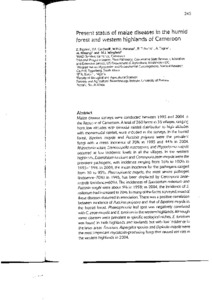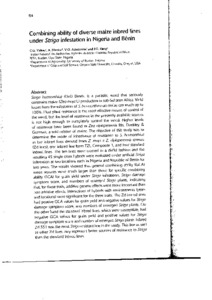Welcome to the International Institute of Tropical Agriculture Research Repository
Conference Documents: Recent submissions
Now showing items 461-480 of 597
-
Comparative performance of common grain legumes in the Sudan savanna zone of Nigeria
(2008)A trial was conducted in minjibir in the sudan savanna zone of Nigeria to evaluate the performance of common grain leguminous crops in the area. Significant differences are found among and within the grain legumes for days to flowering, maturity and ripening. Cowpea had significantly fewer days to flowering, ripening and maturity compared to other legumes. It also has significantly higher threshing % and harvest index. Soybean and cowpea produced significantly higher grain yield than groundnut and ... -
Inventaire et importance des degats des mouche des fruits sur quelques especes de cucurbitacees au Benin
(2008)Le complexe de mouches des fruits ainsi que les taux d'infestation des agrumes avaient été évalués suite à des prospections effectuées dans presque toutes les zones agrùécologiques du Bénin at complétées par des études faites au niveau de trois vergers agrumicoles au Sud du Bénin. Des échantillons de fruits des plantes hôtes potentielles, locaUsées autour de chacun des trois vergers, avaient été aussi prétevés. Bactrocera invadens une aspèce très récemment introduite en Afriqt.ie, était de loin ... -
Contribution of soil quality to banana yield problems and its relation with other banana yield loss factors
(2005)In Uganda, highland banana yields (5-30 t ha-1yr-1) are low in comparison to potential yields (70 t ha-1yr-1) due to high pest and disease pressure, soil fertility decline, and poor management. Although it is generally accepted that soil exhaustion is a major cause of low and declining yields, there are almost no data to demonstrate this relationship. Most studies show that banana soils are relatively fertile and often contain sufficient nutrients for optimum growth. Nonetheless, K, N and Mg ... -
Environmental influences on shoot and root growth in banana and plantain
(2005)Studies on the influence of environmental conditions on Musa plant growth have predominantly focused on dessert bananas (Musa AAA group). The effect of location, field within location and planting date on shoot and root traits of field-grown flowering plants of 6 Musa spp. genotypes belonging to 4 Musa groups was determined in this study. Results show that Musa spp. are highly sensitive to environmental changes and that soil structure, soil fertility and water regime can have significant effects ... -
Banana and plantain (Musa spp.) growth depends on size and physiological stage of planting material
(2005)The influence of the size and physiological stage of the sucker-derived planting material on subsequent root and shoot growth of banana and plantain has not been studied in detail. The objective of this study was to evaluate associations between traits of the sucker planting material and root and shoot traits of the sucker-derived plants for different Musa spp. genotypes. Sucker-derived plants of 2 plantain landraces: 'Bobby Tannap' and 'Obino l'Ewai' and 6 plantain-derived hybrids were assessed. ... -
Nitrogen fixation and balance in burned versus mulched Mucuna pruriens var. utilis and Pueraria phaseoloides relay maize cropping systems
(2006)The contribution of the cover crops Mucuna pruriens var. utilis and Pueraria phaseoloides to the N balance of a sole maize relay cropping system was estimated. Over 4 consecutive years, amounts of N in 8-9 months old aboveground M. pruriens, P. phaseoloides and natural fallow biomass and litter were determined. Fallow biomass was either burned or retained as mulch. Maize aboveground N uptake and N export with grain was determined. The amount of N2-fixed was estimated with the N difference method. ... -
Trends in farm labour productivity and implications for cassava industrialisation in Nigeria
(2006)Nigeria is presently the largest cassava producing country in the world. Cassava production is primarily at the smallholder level relying heavily on the hoe and cutlass and driven by human physical effort. Agricultural farm labour is a critical factor as Nigeria strives to utilise cassava as an industrial crop. With increase in rural urban migration, the aging of the rural population, and the feminisation of agriculture, rural farm labour is likely to remain inelastic and expensive for agro ... -
Effect of Guatamala grass (Tripsacum laxum) mulch applications on soil moisture conservation and soil fertility status
(2007)Mulch applications generally have a large beneficial effect on the productivity of important perennial cash crops in the East African Highlands such as bananas (Musa spp.) and coffee (Coffea spp.), due to the conservation of soil moisture and the improvement of soil fertility. However, the availability of mulch to farmers is often limiting and validated recommendations on optimal mulch thicknesses in the region are absent. Informal interviews with researchers and farmers revealed that a 10 cm mulch ... -
Maize research at IAR Samaru
(2007)Maize (Zea mays L) research at the Institute for Agricultural Research (IAR), Samaru was initiated in the 1950s with the goal of developing adapted high yielding varieties and hybrids. Germplasm materials were collected from local sources as well as from different countries, including Columbia, Kenya, Mexico and the US' By the 1960s. IAR Samaru was actively participating in the National cooperative Trials, the West African Maize Variety Trials of the OAU-STRC Joint Project as well as the East ... -
Risk aversion and sustainable maize production in Nigeria: some challenges and prospects for agricultural and economic development
(2007)This paper determines the degree or extent of farmer’s risk aversion that affects sustainable maize production in Northern Nigeria. Using a ridge regression analysis, a measure of risk aversion was derived for each individual farmer in a model of safety-first behaviour from a cross-sectional survey of 350 maize producers in northern Nigeria. The distribution of the degree of risk aversion shows a high skewness towards the risk averters (high risk farmers) and centered around 1.20, and standard ... -
Genotypic variation of soybean for phosphorus use efficiency and their contribution of N and P to subsequent maize crops in three ecological zones of West Africa
(2007)Soybean is a relatively new crop to most African smallholder farming communities. Cultivation is expanding rapidly because of its perceived potential to enhance soil fertility through biological nitrogen fixation and its source as food and cash. High N2, fixation in promiscuous soybean genotypes is, however, likely to be constrained in low P soils where fertilizer is rarely applied. Thirteen soybean genotypes were evaluated in three ecological zones of Nigeria for (1) N2, fixation, tolerance to ... -
Present status of maize diseases in the humid forest and western highlands of Cameroon
(2007)Maize disease surveys were conducted between 1995 and 2004 inthe Republic of Cameroon. A total of 260 farms in 36 villages, ranging from low altitudes with bimodal rainfall distribution to high altitudes with monomodal rainfall, were included in the surveys. ln the humidforest, Bipolaris maydis and Puccinio polysora were the prevalent fungi with a mean incidence of 70% in 1995 and 44% in 2004. Rhizoctonia solani, Stenocarpella mocrospora, and Physodermo maydisoccurred at low incidence levels in ... -
Colonization of resistant and susceptible maize genotypes by the pink stem borer, Sesamia calamistis (Lepidoptera: Noctuidae)
(2007)The role of four colonizing responses (oviposition, larval arrest, larval establishment and larval feeding) of Sesamia calamistis (Lepidoptera:Noctuidae) in determining the resistance or susceptibility of eight genotypes of maize Zea mays L.) was elucidated. Four resistant (S59-1, 55 1 1-1, 55 27-1 and 55 27-9, two moderately resistant Tzmi 103 and Tzi 4001), and two susceptible 65 20-2 and Tzmi 407) genotypes were used in the study. S. calamistis exhibited variable colonizing responses on the ... -
Genetic analysis of drought tolerance in maize inbred lines: preliminary results
(2007)Drought stress causes significant yield reduction in maize Zea mays L. grown in sub-Saharan Africa (SSA. An understanding of the inheritance of drought tolerance would be useful in developing drought tolerant hybrids. The objectives of this study were to determine (i) the effects of the level of drought tolerance in parental inbred lines on the performance of their hybrids, (ii) mode of inheritance of drought tolerance in inbred lines selected for contrasting responses to drought, and (iii) ... -
Combining ability of diverse maize inbred lines under Striga infestation in Nigeria and Benin
(2007)Striga hermonthica (Del.) Benth. is a parasitic weed that seriously constrains maize (Zea mays L) production in sub-Saharan Africa. Yield losses from the infestation of S. hermonthica on maize can reach up to 100%. Host plant resistance is the most effective means of control of the weed, but the level of resistance in the presently available sources is not high enough to completely control the weed. Higher levels of resistance have been found in Zea diploperennis lltis, Doebley & Guzman, a wild ...

